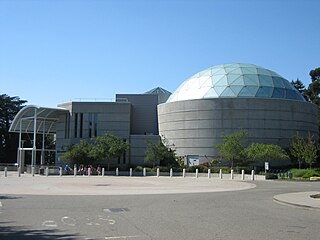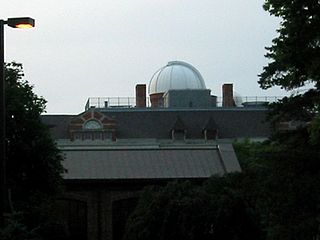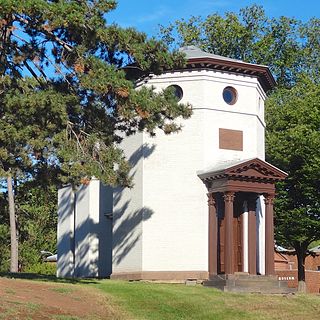
Lowell Observatory is an astronomical observatory in Flagstaff, Arizona, United States. Lowell Observatory was established in 1894, placing it among the oldest observatories in the United States, and was designated a National Historic Landmark in 1965. In 2011, the Observatory was named one of "The World's 100 Most Important Places" by Time Magazine. It was at the Lowell Observatory that the dwarf planet Pluto was discovered in 1930 by Clyde Tombaugh.

Yerkes Observatory is an astronomical observatory located in Williams Bay, Wisconsin, United States. The observatory was operated by the University of Chicago Department of Astronomy and Astrophysics from its founding in 1897 to 2018. Ownership was transferred to the non-profit Yerkes Future Foundation (YFF) in May 2020, which began restoration and renovation of the historic building and grounds. Re-opening for public tours and programming began May 27, 2022.

The Lick Observatory is an astronomical observatory owned and operated by the University of California. It is on the summit of Mount Hamilton, in the Diablo Range just east of San Jose, California, United States. The observatory is managed by the University of California Observatories, with headquarters on the University of California, Santa Cruz campus, where its scientific staff moved in the mid-1960s. It is named after James Lick.

A refracting telescope is a type of optical telescope that uses a lens as its objective to form an image. The refracting telescope design was originally used in spyglasses and astronomical telescopes but is also used for long-focus camera lenses. Although large refracting telescopes were very popular in the second half of the 19th century, for most research purposes, the refracting telescope has been superseded by the reflecting telescope, which allows larger apertures. A refractor's magnification is calculated by dividing the focal length of the objective lens by that of the eyepiece.

The Mauna Kea Observatories (MKO) are a group of independent astronomical research facilities and large telescope observatories that are located at the summit of Mauna Kea on the Big Island of Hawaiʻi, United States. The facilities are located in a 525-acre (212 ha) special land use zone known as the "Astronomy Precinct", which is located within the 11,228-acre (4,544 ha) Mauna Kea Science Reserve. The Astronomy Precinct was established in 1967 and is located on land protected by the Historical Preservation Act for its significance to Hawaiian culture. The presence and continued construction of telescopes is highly controversial due to Mauna Kea's centrality in native Hawaiian religion and culture, as well as for a variety of environmental reasons.

McDonald Observatory is an astronomical observatory located near unincorporated community of Fort Davis in Jeff Davis County, Texas, United States. The facility is located on Mount Locke in the Davis Mountains of West Texas, with additional facilities on Mount Fowlkes, approximately 1.3 kilometers (0.81 mi) to the northeast. The observatory is part of The University of Texas at Austin. It is an organized research unit of the College of Natural Sciences.
Boyden Observatory is an astronomical research observatory and science education centre located in Maselspoort, 20 kilometres (12 mi) north-east of the city of Bloemfontein in Free State, South Africa. The observatory is managed by the Physics Department of the University of the Free State (UFS). The Friends of Boyden assist the observatory as a public support group, organising open evenings and protecting its public interest. Boyden also makes use of members of ASSA Bloemfontein Centre, the amateur astronomy club of the city, for presenters and telescope assistants.

The Cincinnati Observatory is located in Cincinnati, Ohio on top of Mount Lookout. It consists of two observatory buildings housing an 11-inch (28 cm) and 16 inch (41 cm) aperture refracting telescope. It is the oldest professional observatory in the United States. It was a key facility for astronomical research and education at the University of Cincinnati and currently operates as a 19th-century observatory. There are regular viewings through both historical telescopes as well as tours and additional programs. The observatory also has an extensive outreach program, providing astronomical education for the Ohio/Kentucky/Indiana region.

The National Astronomical Observatory of Japan (NAOJ) is an astronomical research organisation comprising several facilities in Japan, as well as an observatory in Hawaii and Chile. It was established in 1988 as an amalgamation of three existing research organizations - the Tokyo Astronomical Observatory of the University of Tokyo, International Latitude Observatory of Mizusawa, and a part of Research Institute of Atmospherics of Nagoya University.

The Leander McCormick Observatory is one of the astronomical observatories operated by the Department of Astronomy of the University of Virginia, and is situated just outside Charlottesville, Virginia (US) in Albemarle County on the summit of Mount Jefferson. It is named for Leander J. McCormick (1819–1900), who provided the funds for the telescope and observatory.

The Royal Observatory, Edinburgh (ROE) is an astronomical institution located on Blackford Hill in Edinburgh. The site is owned by the Science and Technology Facilities Council (STFC). The ROE comprises the UK Astronomy Technology Centre (UK ATC) of STFC, the Institute for Astronomy of the School of Physics and Astronomy of the University of Edinburgh, and the ROE Visitor Centre.

Sherzer Hall is an academic building on the Eastern Michigan University campus, located in Ypsilanti, Michigan. Sherzer Hall is one of four buildings comprising the Eastern Michigan University Historic District on the National Register of Historic Places. The building was designed by E. W.. Arnold of Battle Creek and survived two fires. Sherzer Hall has a red-brick exteriors Sherzer's exterior has a few mildly Romanesque and Georgian elements. Due to its unique style causes it to defies stylistic classification. Sherzer also is home to Sherzer Observatory which was established in 1878 and eventually moved to the top of Sherzer Hall in 1903.

Sproul Observatory was an astronomical observatory owned and operated by Swarthmore College. It was located in Swarthmore, Pennsylvania, United States, and named after William Cameron Sproul, the 27th Governor of Pennsylvania, who graduated from Swarthmore in 1891. The 24" telescope was moved from Sproul Observatory to Bentonville, Arkansas in July 2017

Chabot Space and Science Center, located in Oakland, California, is a center for science learning featuring interactive exhibits, planetariums, a large screen theater, hands-on activities and three powerful telescopes.

The University of Illinois Astronomical Observatory, located at 901 S. Mathews Avenue in Urbana, Illinois, on the campus of the University of Illinois Urbana–Champaign, was built in 1896, and was designed by Charles A. Gunn. It was listed on the National Register of Historic Places on November 6, 1986, and on December 20, 1989, was designated a National Historic Landmark.

Sherzer Observatory is an astronomical observatory located on the campus of Eastern Michigan University. The observatory was established in 1903 with the construction of the new Natural Science Building, in Ypsilanti, Michigan. Following a devastating fire in 1989 a new observatory opened in September 1991 with a 10-inch (250 mm) apochromatic refractor telescope and German equatorial mount centered under a 6-meter dome.

The Daniel S. Schanck Observatory is an historical astronomical observatory on the Queens Campus of Rutgers University in New Brunswick, New Jersey, United States, and is tied for the seventh oldest observatory in the US alongside the Vassar College Observatory. It is located on George Street near the corner with Hamilton Street, opposite the parking lot adjacent to Kirkpatrick Chapel, and to the northeast of Old Queens and Geology Hall.

















